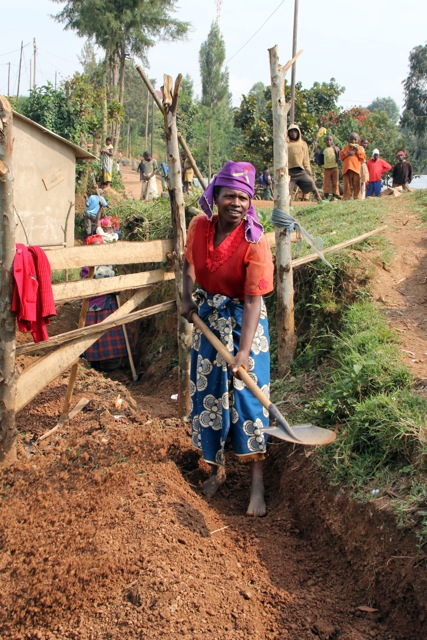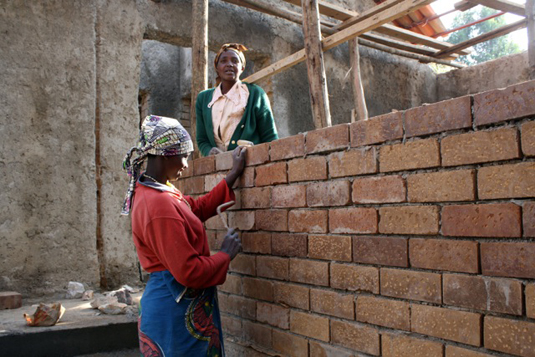A year ago I didn’t expect to live in Rwanda and be working in health care, but there I was. All this happened after I got a Global Health Corps fellowship to work with MASS Design Group. For the past few months I have been helping them oversee the construction of a doctors’ housing project in the country’s northern region, near Butaro Hospital. In addition I have been working to design a cancer infusion center, the first of its kind in the country. These two opportunities have given me firsthand knowledge of how much good architectural design can do to improve lives through capacity building as well as the use of local materials and labor.
MASS’s mission is to use architecture to improve lives. This includes creating successful outcomes in what gets built, as well as how people are impacted over the course of the entire project.
The first thing I got to work on as a Global Health Corps fellow was a housing project, which was to be a learning community where foreign and Rwandan doctors could share their knowledge both in and outside of the workplace. The project also created the opportunity to train local residents on how to construct houses.
I arrived at the construction site not knowing a word of Kinyarwanda, the local language. But we were communicating from the start; the workers’ infectious smiles brought joy to my daily experience. I soon learned the words to greet each and every one of them, each morning. Over the next few months, I was able to see a simple laborer move up the ranks to be a skilled mason, and then a team leader. I befriended the female masons on site, proud of their work and proud to be doing a job that, in Rwanda, is considered to be a man’s domain.
One of the most rewarding parts of the project was when the construction came to a close. The site crew gathered together for a big celebration that lasted for hours. Speeches of appreciation and pride of being able to contribute to the project were made. One story stood out in particular, that of a married couple whose home was located at the entrance to the construction site. The wife worked on the landscape, planting wildflower seeds and grass that had been collected from the surrounding land. The husband was a mason, working on the stone walls that support the soil beneath the houses scattered on the steep hillside. Their children would play near the site each day, eagerly waiting to say hello to anyone who passed their way. What they loved most about the project was not simply the buildings themselves, but the support systems the project brought to the surrounding village. New gutters along the road leading up to the site and the better retaining system that protected their family’s home from the threat of damage brought by heavy rains, and made a safer place for their children to play and grow up in. The couple, along with the other workers, showed their gratitude openly on that final day of the project. They had acquired many new skills, and were happy to have contributed to the improvement of their community.
Building in rural Rwanda was an eye-opening experience for me. We did not have access to standard or pre-fabricated materials that the other housing projects in more prosperous regions could draw from. Instead, building in a rural area meant relying on what could be easily procured or made on site. I was amazed to see the entirety of the process, like the local volcanic stone delivered by trucks, refined by the workers, and then made into an intricate wall system. This was an intense lesson in locality, economy, and ingenuity— all without sacrificing the design and functionality of the buildings. It was gratifying to know that I had witnessed the fabrication of almost every item that went into the houses, from furniture built on site by the carpenters to the lighting fixtures made in collaboration with the welder who worked on the site. The project invested in the skill of the workers, instead of expensive materials. It reminded me of the beauty in the process of making a building, how important it is to build with local materials, and to support the local economy.
Over the course of my architectural education, I absorbed the idea that architecture can change people’s lives. I always assumed that it was through the power of well-designed buildings, ones that could create an awe-inspiring experience. It took me a while to question this notion, and think about how design could change people’s lives beyond aesthetic considerations.
Well-designed buildings can create dignity, but the process of building is also an opportunity to effect change. As one of the few designers in the Global Health Corps fellowship program, I found it interesting yet perplexing to feel like an anomaly in a group representing other skills.
I am surprised that there are so few young architects and designers involved in global health. My co-fellows ask, eagerly and often, what I do for my fellowship, and how design can contribute to global health. They are puzzled to hear that architects should be included in the dialogue of how to improve health care systems, alongside medicine, education, and agriculture. I can see the excitement in their eyes as they begin to realize a new way to think about health care, and how to improve other aspects of people’s lives along the way.
I am proud to be part of the movement of emerging designers engaged in public interest design. And I hope that others, too, will be fortunate enough to have the same opportunity that I have had, and join the movement so key to our future, and the future of people who really need our skills.




